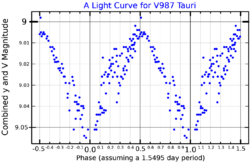Astronomy:HD 283572
Coordinates: ![]() 04h 21m 58.8483s, +28° 18′ 06.5119″
04h 21m 58.8483s, +28° 18′ 06.5119″
 A combined y band (near-infrared) and visual band light curve for V987 Tauri, adapted from Strassmeier and Rice (1998)[1] | |
| Observation data Equinox J2000.0]] (ICRS) | |
|---|---|
| Constellation | Taurus |
| Right ascension | 04h 21m 58.8483s[2] |
| Declination | +28° 18′ 06.5119″[2] |
| Characteristics | |
| Evolutionary stage | pre-main-sequence star[3] |
| Spectral type | G5[4] |
| Apparent magnitude (B) | 9.80[2] |
| Apparent magnitude (g) | 8.80[5] |
| Apparent magnitude (R) | 9.14[2] |
| Apparent magnitude (J) | 7.414[2] |
| Variable type | T Tau[4] |
| Astrometry | |
| Radial velocity (Rv) | 15.0±1.5[4] km/s |
| Proper motion (μ) | RA: 8.84±0.03[5] mas/yr Dec.: -26.426±0.017[5] mas/yr |
| Parallax (π) | 7.8735 ± 0.0190[5] mas |
| Distance | 414.2 ± 1.0 ly (127.0 ± 0.3 pc) |
| Details[4] | |
| Mass | 1.6 M☉ |
| Radius | 2.2 R☉ |
| Luminosity | 5.5 L☉ |
| Temperature | 5770 K |
| Metallicity [Fe/H] | 0.7±0.2[3] dex |
| Rotation | 1.55 d[3] |
| Rotational velocity (v sin i) | 78[3] km/s |
| Age | 9 Myr |
| Other designations | |
HDE 283572, 2MASS J04215884+2818066, BD+27 657, GSC 01828-00481, HIP 20388, TYC 1828-481-1, V987 Tauri, Gaia DR2 164536250037820160 | |
| Database references | |
| SIMBAD | data |
HD 283572 is a young T Tauri-type pre-main sequence star in the constellation of Taurus about 414 light years away, belonging to the Taurus Molecular Cloud.[3] It is a rather evolved protostar which already dispersed its birth shroud.[4] The star emits a very high X-ray flux of 1031 ergs/s. That radiation flux associated with the magnetic activity induced a high coronal temperature of 3 kEv and regular flares.[6] HD 283572 will eventually evolve to an A-type main-sequence star when on the main sequence.[3] It is no longer accreting mass, and is magnetically decoupled from the remnants of the protoplanetary disk,[3] belonging to the terminal, 3rd phase of the disk evolution.[7]
Protoplanetary system
HD 283572 is surrounded by a light (<0.0004 M☉) and faint protoplanetary disk with uncertain inclination. Different instruments yielded measurements of disk inclination to the plane of sky from 35 to 60 degrees.[7] A search for planetary transits was performed but no planets were detected as of 2019.[8]
References
- ↑ Strassmeier, K. G.; Rice, J. B. (November 1998). "Doppler imaging of stellar surface structure. IX. A high-resolution image of the weak-lined T Tauri star HDE 283572 = V987 Tauri". Astronomy and Astrophysics 339: 497–506. Bibcode: 1998A&A...339..497S. https://ui.adsabs.harvard.edu/abs/1998A&A...339..497S. Retrieved 8 April 2022.
- ↑ 2.0 2.1 2.2 2.3 2.4 "HD 283572". SIMBAD. Centre de données astronomiques de Strasbourg. http://simbad.u-strasbg.fr/simbad/sim-basic?Ident=HD+283572.
- ↑ 3.0 3.1 3.2 3.3 3.4 3.5 3.6 Scelsi, L.; Maggio, A.; Peres, G.; Pallavicini, R. (2005), "Coronal properties of G-type stars in different evolutionary phases", Astronomy & Astrophysics 432 (2): 671–685, doi:10.1051/0004-6361:20041739, Bibcode: 2005A&A...432..671S
- ↑ 4.0 4.1 4.2 4.3 4.4 Torres, Rosa M.; Loinard, Laurent; Mioduszewski, Amy J.; Rodriguez, Luis F. (2007), "VLBA Determination of the Distance to Nearby Star-forming Regions. II. Hubble 4 and HDE 283572 in Taurus", The Astrophysical Journal 671 (2): 1813–1819, doi:10.1086/522924, Bibcode: 2007ApJ...671.1813T
- ↑ 5.0 5.1 5.2 Brown, A. G. A. (2021). "Gaia Early Data Release 3: Summary of the contents and survey properties". Astronomy & Astrophysics 649: A1. doi:10.1051/0004-6361/202039657. Bibcode: 2021A&A...649A...1G. Gaia EDR3 record for this source at VizieR.
- ↑ Favata, F.; Micela, G.; Sciortino, S. (1998), "X-ray spectroscopy of the weak-lined T Tauri star HD 283572", Astronomy and Astrophysics 336: 413–420, Bibcode: 1998A&A...337..413F
- ↑ 7.0 7.1 Yasui, Chikako; Hamano, Satoshi; Fukue, Kei; Kondo, Sohei; Sameshima, Hiroaki; Takenaka, Keiichi; Matsunaga, Noriyuki; Ikeda, Yuji et al. (2019), "Possible Progression of Mass-flow Processes around Young Intermediate-mass Stars Based on High-resolution Near-infrared Spectroscopy. I. Taurus", The Astrophysical Journal 886 (2): 115, doi:10.3847/1538-4357/ab45ee, Bibcode: 2019ApJ...886..115Y
- ↑ Hambálek, Ľ.; Vaňko, M.; Paunzen, E.; Smalley, B. (2019), "T Tauri stars in the SuperWASP and NSVS surveys", Monthly Notices of the Royal Astronomical Society 483 (2): 1642–1654, doi:10.1093/mnras/sty3151, Bibcode: 2019MNRAS.483.1642H
 |

